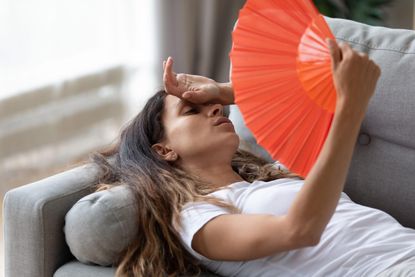Heat exhaustion symptoms and how to treat them
Make sure you take care of your health while you're enjoying the sun today. We've got the facts on why heat can be dangerous and what to do to protect yourself and your kids...

Heat exhaustion symptoms can become serious but are also treatable within 30 minutes if you are aware of the signs, and what to do as soon as it happens.
When a heatwave comes to the UK, we all know we need to protect our skin from sunburn by using the best sunscreens and keeping hydrated. But our good intentions can often fall by the wayside, leading to heat exhaustion and the more serious condition of heatstroke.
As around 900 people in the UK are believed to have died as a result of the heatwave in 2021, it's important to be aware of the dangers. GP Dr Angela Rai explains. “Being exposed to too much heat can lead to you feeling generally unwell, lacking in energy, and feeling dizzy or sick. The body tries to regulate its temperature, heatstroke happens when your body's normal mechanisms for regulating your temperature break down, and your temperature rises to more than 40°C. Heat exhaustion should be treated quickly to prevent it from turning into heatstroke.”
What is heat exhaustion?
Heat exhaustion happens when you spend too much time in the sunshine and your body temperature begins to rise, leading to headaches, nausea, and dizziness. If left untreated, heat exhaustion can lead to heatstroke which is even more serious and often requires a visit to hospital.
And it's not just ourselves we need to look out for - babies, toddlers, the elderly, and those with chronic health conditions are more at risk of dehydration and heat exhaustion, too, says Dr. Rai. “It is important to remember that it is possible to develop heat exhaustion even when you are not in direct sunlight," she adds.
Sitting under the shade of a tree might feel more cooling, but it doesn't mean you aren't at risk of heat exhaustion. Instead, you need to rely on other methods of staying cool, such as hydrating.
Heat exhaustion symptoms
- A headache
- Dizziness
- Clammy, pale skin
- Excessive sweating
Other symptoms can include:
GoodtoKnow Newsletter
Parenting advice, hot topics, best buys and family finance tips delivered straight to your inbox.
- Stomach, leg and arm cramps
- Feeling breathless
- A fast pulse rate
- A temperature above 38C
- Excessive thirst
- Reduced, darker coloured urine
- Loss of appetite
- Nausea and/or vomiting
- Children may become sleepy or floppy
Superintendent pharmacist Abbas Kanani told us, “Typical signs to look out for include a headache, dizziness and confusion, increased thirst, a high body temperature above 38 degrees, and heavy sweating." If you or your family members experience any of these, it is time to get out of the sunshine and rehydrate. Do not be tempted to go out again once you feel a bit more stable - you need to take time to settle your body and temperature.

How to treat heat exhaustion
If you suspect someone is deteriorating with heat exhaustion, you also need to try to prevent heatstroke. You need to be especially careful when it comes to babies, toddlers, the elderly, or those with chronic health conditions.
The good news is that, if you are alert and ready to take action, you can stop heat exhaustion in its tracks.
To help someone recover from heat exhaustion, follow these steps:
- Get them to a shady or cooler place
- Lie them down, and raise their feet slightly if you can
- Try and help them get some fluids such as water or a sports drink
- Help them lower their body temperature.
"It is important to remember that it is possible to develop heat exhaustion even when you are not in direct sunlight,” adds Dr Angela Rai.
Drinking fluids is key, not just to help cool you down, but also to replace electrolytes. Electrolytes are salts and minerals that are essential to keep our bodies functioning in the correct way, and include calcium, potassium and sodium.
“When you become dehydrated, you will also need to replace electrolytes. Children and adults lose fluids and electrolytes, so drink plenty of water and other fluids, especially if you are very physically active. You can buy special oral rehydration sachets for children and adults from pharmacies,” she adds.
How long does it take to recover from heat exhaustion?
It can take up to 30 minutes to begin to recover from heat exhaustion. For some, it can take up to an hour to recover from heat exhaustion. If it takes longer for you or someone you're helping, it's best to seek medical attention.
“The condition is not usually serious if effectively managed and the body is cooled down within 30 minutes. Reducing body temperature can be achieved by cooling the skin, lying flat with feet slightly raised, moving to a cool shaded area, and drinking plenty of water,” adds Abbas Kanani.
There are some ingenious ways you can cool down fast, from closing the curtains if you're at home, to applying ice cubes to the skin. Try peppermint tea, or even coconut water, which contains those all-important electrolytes.
Heat exhaustion vs heat stroke
Feeling thirsty is a clear and strong sign something’s wrong. Add in dizziness and a headache and you could be heading for heat exhaustion. However, sunstroke, also known as heatstroke, is far worse and is a condition caused by your body overheating – to a temperature above 70C (104F).
It may start as heat exhaustion and is rarely serious if you cool your body down immediately. But if your body temperature rises, heat exhaustion can develop into heat stroke which is a serious medical emergency.
Heatstroke is considered a serious injury, and should not be ignored or taken lightly. You need urgent medical attention if you’re affected. Dr Angela Rai says. “Heatstroke is the most serious form of heat injury and is a medical emergency. You should seek urgent medical attention or call 999 if you suspect someone has heatstroke."
There are some clear symptoms of heatstroke, she adds, such as fast breathing, shortness of breath, feeling confused or even having a seizure.
"Heatstroke occurs after progression from milder heat-related symptoms, to heat exhaustion and eventually heat stroke. Symptoms and signs of heatstroke include a temperature of or above 40 degrees C, fast breathing and shortness of breath, still feeling unwell after resting and cooling off for 30 minutes, feeling confused, having a seizure, loss of consciousness or not being responsive."
How to avoid heat exhaustion
The key element to avoiding heat exhaustion symptoms is hydration. This is quite simple, of course - drinking more water, avoiding alcohol and caffeinated drinks, which can dehydrate you.
Preparation and planning can help you avoid heat exhaustion, too. Check the weather forecast before you head out for the day, and if you're going somewhere like the beach or park, take something to shade you like a small day tent, a hat, sunscreen, and plenty of water. A cool box or bag with ice and ice packs in is also a great idea for preventing heat exhaustion as it'll be on hand when you need to cool down.
To prevent dehydration and heat exhaustion, Dr. Angela Rai advises:
- Increase fluid intake. Keep caffeinated drinks in moderation.
- Avoid alcohol, which dehydrates you and reduces your awareness of the warning symptoms.
- Avoid strenuous exercise in hot weather (especially between 11 am and 3 pm when temperatures are usually highest).
- Wear loose clothes made from natural fibers such as cotton or linen, which allow your body to evaporate heat readily by sweating.
- Keep your home cool by using a fan.
- Take regular cool showers or baths.
- If you are feeling hot, put a damp flannel on the back of your neck and keep changing it. As the water evaporates from your skin, it will cool you down.
It's not just humans who need protection from heatstroke. Find out how to protect your pet during a heatwave
Video of the Week
-
 Who did Bluey have a baby with? Fan theories are running wild following the cartoon’s season 3 finale (our money is on Mackenzie)
Who did Bluey have a baby with? Fan theories are running wild following the cartoon’s season 3 finale (our money is on Mackenzie)The 'Surprise!’ episode has really done what it says on the tin - and many can’t get over the shock of Bluey having a baby
By Charlie Elizabeth Culverhouse Published
-
 Prince George, Charlotte and Louis are huge fans of this popular tinned food - and it’s not what you’d expect from the royals
Prince George, Charlotte and Louis are huge fans of this popular tinned food - and it’s not what you’d expect from the royalsRoyal meal times are more similar to the average family's than you might imagine
By Charlie Elizabeth Culverhouse Published